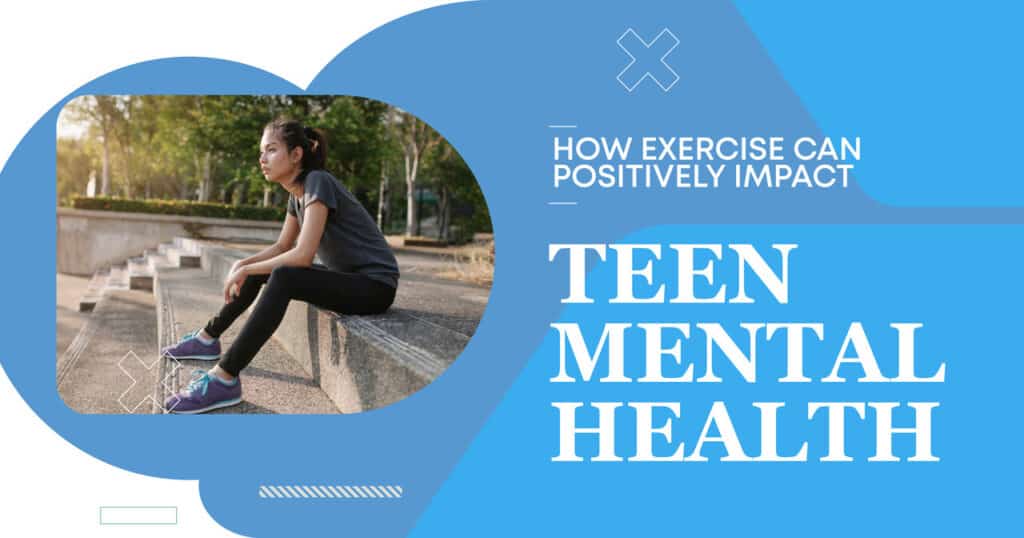The Impact of Exercise on Teen Mental Health
Ah, the teenage years—a time of growth, discovery, and sometimes, a lot of stress. Between navigating school, friendships, and the rollercoaster of emotions that come with growing up, it’s no wonder teens can feel overwhelmed. In fact, many school students today face serious mental health challenges due to factors like academic pressure, social media platform influences, and environmental factors. These pressures can exacerbate underlying mental health conditions or lead to the development of new mental health disorders, affecting both their emotional and physical health. But here’s the silver lining: exercise. Yep, that’s right! Getting moving isn’t just about staying fit; it can also work wonders for mental health, particularly in combating mental health conditions and disorders. Let’s dive into how exercise can positively impact teen mental health and why it’s a game-changer for today’s youth.
The Science Behind Exercise and Mental Health
First things first, let’s talk about the science. When we exercise, our bodies release chemicals that can profoundly affect our mood and brain function, which is critical in managing mental health disorders like Generalized Anxiety Disorder or depression in adolescents. These conditions are not uncommon in youth, with many experiencing anxiety symptoms or attention-deficit/hyperactivity disorder (ADHD) as part of their daily struggles.
Chemical Boosters
- Endorphins: Often called the “feel-good” hormones, endorphins act as natural painkillers and mood elevators.
- Serotonin: Regular exercise can increase serotonin levels, which helps regulate mood, sleep, and appetite, making it effective in mental health treatment.
- Dopamine: Physical activity can boost dopamine, enhancing motivation and focus, crucial for teens facing mental health issues or even obsessive-compulsive disorder (OCD).
Brain Benefits
- Neurogenesis: Exercise promotes the growth and production of new brain cells, particularly in the hippocampus, an area crucial for memory and learning. This is especially important for teens with developmental disorders or those managing the long-term effects of adverse childhood experiences.
- Brain Plasticity: Physical activity enhances the brain’s ability to adapt and form new neural connections, which can be beneficial for youth with disabilities or those who have experienced traumatic events.
How Exercise Can Positively Impact Teen Mental Health
So, what’s the big deal? How does all this translate to better mental health for teens?
Mood Enhancement
Have you ever heard of a “runner’s high”? It’s real. Exercise triggers the release of endorphins, which lead to a feeling of happiness and euphoria. For teens battling depression or anxiety symptoms, even a short workout can provide a much-needed mood boost. The National Institute of Mental Health recognizes this effect as part of holistic mental health care. Engaging in regular physical activity can also reduce feelings of sadness and persistent feelings of emotional distress.
Stress Reduction
Exercise is a fantastic stress-buster. It lowers levels of the body’s stress hormones, like cortisol, and helps release tension physically and mentally. After a tough day at school, where school experiences can be particularly taxing, a quick run or dance session can work wonders in alleviating negative emotions and helping teens manage difficult emotions. The American Academy of Pediatrics notes that physical activity plays a key role in reducing the emotional load teens carry.
Improved Sleep
Goodbye, sleepless nights! Regular physical activity can help teens fall asleep faster and have deeper sleep, improving their mood and energy levels during the day. This is particularly important for teens who might suffer from mental disorders, chronic illness, or who face issues like suicidal ideation.
Increased Self-Esteem
Whether running a mile or mastering a yoga pose, accomplishing fitness goals can significantly boost a teen’s confidence. Feeling stronger and more capable physically can translate to better self-esteem overall, which is essential for managing mental health disorders and fostering a supportive environment for growth.
Enhanced Cognitive Function
Exercise isn’t just good for the body; it’s also a brain booster. Physical activity improves concentration, memory, and classroom behavior, making it easier for teens to succeed academically, especially those dealing with attention-deficit disorder or ADHD.
Types of Exercise for Mental Health Benefits
Not all exercise is created equal, but the good news is that almost any form of physical activity can be beneficial. Here are some top picks:
Aerobic Exercise
Activities like running, cycling, swimming, or brisk walking can stimulate the heart and release those feel-good chemicals, making them an excellent option for teens dealing with behavioral health conditions like anxiety disorders or social anxiety disorder.
Strength Training
Lifting weights or engaging in body-weight exercises can improve muscle tone and strength, which increases self-confidence. This is crucial for youth facing mental illnesses or struggling with suicidal behaviors.
Yoga and Pilates
These practices combine physical movement with mindfulness, helping teens reduce stress, improve flexibility, and foster a sense of inner peace. This is vital for those navigating behavioral health care or who are dealing with traumatic events.
Team Sports
Participating in sports such as soccer, basketball, or volleyball provides physical benefits and encourages social interaction and teamwork. This is especially beneficial for teens struggling with social anxiety disorder or suicidal ideation, as it fosters a sense of belonging and reduces risk factors for suicidal behaviors.
Dance
Whether it’s a structured dance class or just Zumba dancing around the living room, moving to music can be a joyful and expressive exercise that reduces feelings of sadness and promotes positive behaviors.
Overcoming Barriers to Exercise
Despite the clear benefits, getting teens to exercise regularly can be challenging. Here are some common barriers and how to overcome them:
Lack of Time
Finding time to exercise can be challenging between homework, extracurricular activities, and socializing. The trick is to integrate physical activity into daily routines, much like how schools could incorporate mental health services for students’ overall well-being.
Lack of Motivation
Sometimes, teens don’t feel like moving. Setting achievable goals, mixing up the types of exercise, and making it fun can keep motivation high. Programs like the 988 Suicide and Crisis Lifeline have noted how structured activities can help in reducing mental health struggles.
Limited Access to Facilities
Not everyone has access to a gym or sports equipment, but exercise doesn’t require fancy facilities. Body-weight exercises, running, or even using household items for resistance training can be effective. This aligns with broader initiatives from the U.S. Department of Health and Human Services to promote health care providers incorporating physical wellness into mental health crisis intervention.
Self-Consciousness
Teens can be self-conscious about their bodies and abilities, which may deter them from exercising. Encouraging a positive, non-judgmental environment and focusing on the fun and benefits of movement rather than performance can help.
Success Stories: Real-Life Examples
Let’s take a look at some real-life examples of how exercise has positively impacted teen mental health:
Jane’s Story
Jane, a high school sophomore, struggled with anxiety and low self-esteem. She started attending a local yoga class twice a week. Over time, she noticed reduced anxiety levels and felt more confident in her skin. Yoga became her sanctuary, where she could escape her worries and focus on the present moment, a practice supported by findings from the American Academy of Pediatrics.
Michael’s Journey
Michael, a 16-year-old soccer player, was dealing with depression after a family crisis. His coach suggested he channel his energy into practice and games. The camaraderie with his teammates and the physical exertion helped him manage his emotions and regain a sense of normalcy and joy, which also aligns with findings from the Child Mind Institute on the benefits of structured physical activity for mental health treatment.
FAQs
How much exercise is recommended for teens?
The CDC recommends at least 60 minutes of moderate to vigorous physical activity daily for teens.
Can exercise replace medication for depression or anxiety?
Exercise can be a powerful complementary treatment, but it should not be used in place of professional medical advice or prescribed medication. Always consult with a health care provider.
Wrapping It Up
Incorporating regular exercise into a teen’s routine can be a game-changer for their mental health. The benefits are immense, from boosting mood and reducing stress to improving sleep and self-esteem. By finding activities they enjoy and creating a supportive environment, we can help teens harness the power of physical activity to navigate the challenges of adolescence with resilience and joy. Moreover, organizations like the Center for Mental Health Services and the National Institute of Mental Health advocate for more holistic approaches to treating mental disorders, emphasizing the role of physical wellness in overall mental health care.




